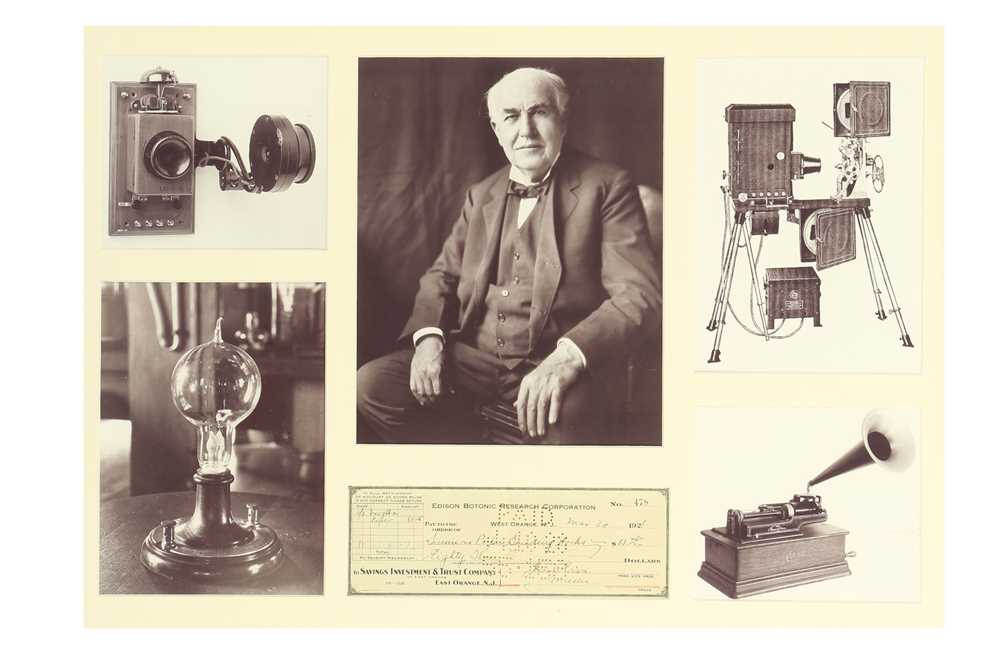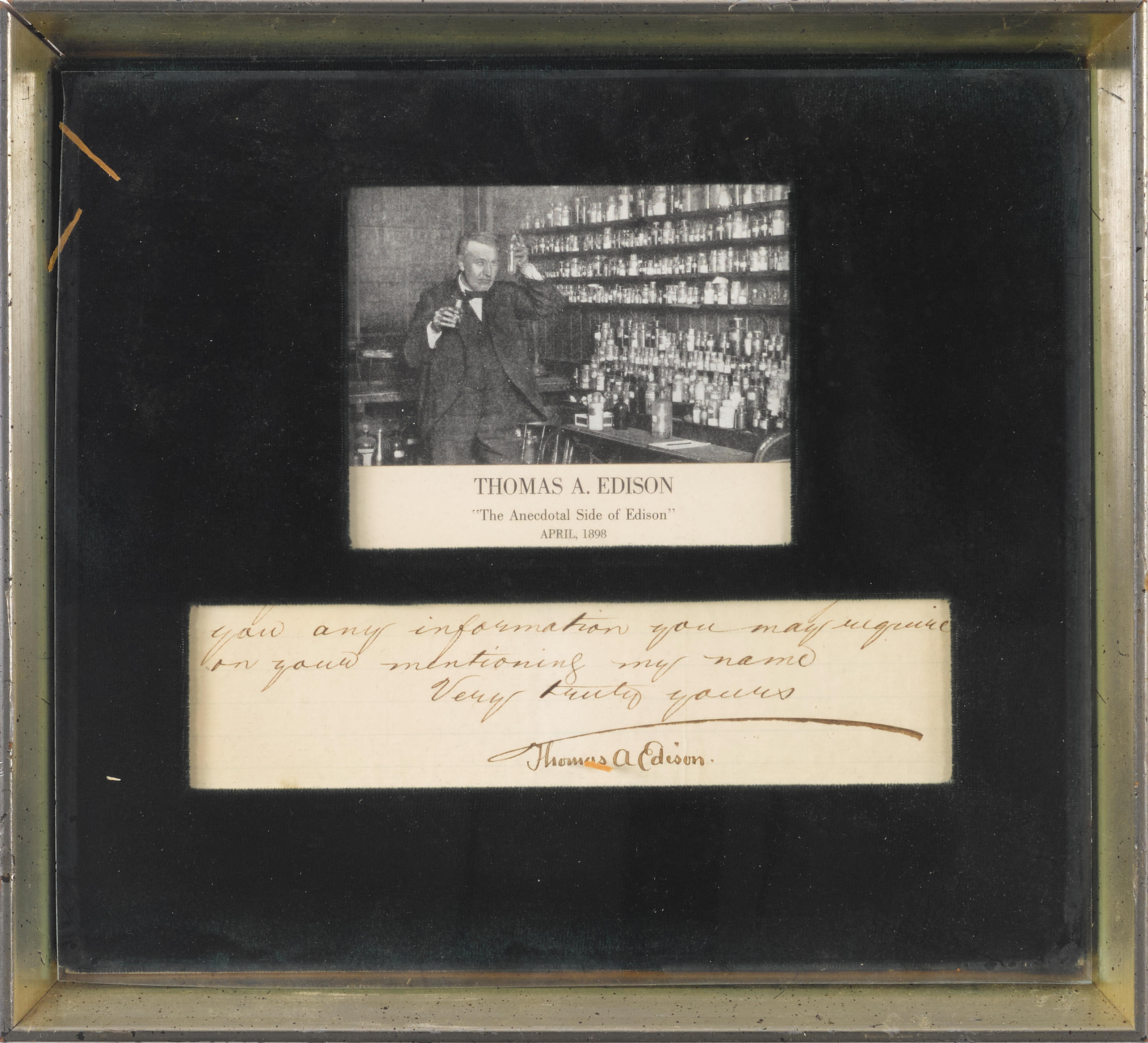EDISON, Thomas Alva (1847-1931). A repeating telegraph disk, signed and inscribed ("Recorded in the Laboratory of Thomas A. Edison Tuesday 5/13/80"), [Menlo Park,] 13 May 1880. 163 x 170mm, thick paper stock with embossed dots in a spiral formation surrounding a central spindle hole (Small loss at top right and bottom left corners, scattered foxing and mild dampstain). Thomas Edison's inspiration for recorded sound. An extremely rare survival – the only known example in private hands – representing some of Thomas Edison's earliest work, which involved improvements in telegraphy that also inspired him to develop recorded sound. His first major breakthrough was the Universal Stock Printer, followed by automatic and multiplex telegraphs. Over the same period, Edison developed seemingly unrelated inventions such as the electric pen as well as the carbon telephone transmitter which allowed Edison and his staff opportunities to incorporate ideas from one invention into another. The development of the phonograph was no exception. There are two known stories concerning Edison's inspiration to develop recorded sound. One points to a transmitter diaphragm as the inspiration for this technology as Edition felt the vibrations produced by a pin hitting against the membrane. The other story concerns his Embossing and Translating Telegraph (or Repeating Telegraph), which allowed for a permanent record of a telegraph transmission that could be re-sent at a later time. A paraffin-coated card (called a disk) was placed on a machine consisting of two spinning plates on a common base. Above this hung a stylus, attached to a telegraph key, that would emboss the paper, thus preserving the Morse code message. The paper disk bearing the "recording" would be placed on the second plate, which in turn would read the indentations, allowing for the message to be retransmitted over the wires. When the disk spun at a high speed it emitted a humming noise that resembled human speech. From this, Edison was said to have been inspired to investigate sound recording. Francis Jehl, a longtime assistant, quoted Edison as saying, "That machine was the father of the phonograph." Edison received his patent for the device: "Improvement in Automatic Telegraphs" on 26 March 1877. The same year he also patented his carbon transmitter for telephony that vastly improved Bell's invention. Both of these devices inspired Edison's foray into designing an experimental cylinder phonograph the same year (flat discs would follow 25 years later) – a device so novel for the time, that Edison was dubbed "The Wizard of Menlo Park." There are only two extant examples of Edison's Embossing and Translating Telegraph: one at Edison National Historic Site in Orange, New Jersey, and the other at the Henry Ford Museum in Dearborn, Michigan. This is the only known Repeating Telegraph disk in private hands. Provenance: Collection of George Frow – Skinner, Boston 3 May 2003, lot 303.
EDISON, Thomas Alva (1847-1931). A repeating telegraph disk, signed and inscribed ("Recorded in the Laboratory of Thomas A. Edison Tuesday 5/13/80"), [Menlo Park,] 13 May 1880. 163 x 170mm, thick paper stock with embossed dots in a spiral formation surrounding a central spindle hole (Small loss at top right and bottom left corners, scattered foxing and mild dampstain). Thomas Edison's inspiration for recorded sound. An extremely rare survival – the only known example in private hands – representing some of Thomas Edison's earliest work, which involved improvements in telegraphy that also inspired him to develop recorded sound. His first major breakthrough was the Universal Stock Printer, followed by automatic and multiplex telegraphs. Over the same period, Edison developed seemingly unrelated inventions such as the electric pen as well as the carbon telephone transmitter which allowed Edison and his staff opportunities to incorporate ideas from one invention into another. The development of the phonograph was no exception. There are two known stories concerning Edison's inspiration to develop recorded sound. One points to a transmitter diaphragm as the inspiration for this technology as Edition felt the vibrations produced by a pin hitting against the membrane. The other story concerns his Embossing and Translating Telegraph (or Repeating Telegraph), which allowed for a permanent record of a telegraph transmission that could be re-sent at a later time. A paraffin-coated card (called a disk) was placed on a machine consisting of two spinning plates on a common base. Above this hung a stylus, attached to a telegraph key, that would emboss the paper, thus preserving the Morse code message. The paper disk bearing the "recording" would be placed on the second plate, which in turn would read the indentations, allowing for the message to be retransmitted over the wires. When the disk spun at a high speed it emitted a humming noise that resembled human speech. From this, Edison was said to have been inspired to investigate sound recording. Francis Jehl, a longtime assistant, quoted Edison as saying, "That machine was the father of the phonograph." Edison received his patent for the device: "Improvement in Automatic Telegraphs" on 26 March 1877. The same year he also patented his carbon transmitter for telephony that vastly improved Bell's invention. Both of these devices inspired Edison's foray into designing an experimental cylinder phonograph the same year (flat discs would follow 25 years later) – a device so novel for the time, that Edison was dubbed "The Wizard of Menlo Park." There are only two extant examples of Edison's Embossing and Translating Telegraph: one at Edison National Historic Site in Orange, New Jersey, and the other at the Henry Ford Museum in Dearborn, Michigan. This is the only known Repeating Telegraph disk in private hands. Provenance: Collection of George Frow – Skinner, Boston 3 May 2003, lot 303.















Testen Sie LotSearch und seine Premium-Features 7 Tage - ohne Kosten!
Lassen Sie sich automatisch über neue Objekte in kommenden Auktionen benachrichtigen.
Suchauftrag anlegen